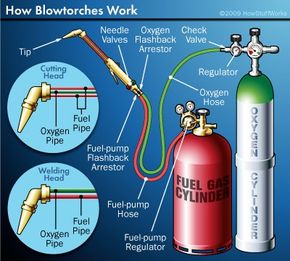Blowtorch Components
Gas blowtorches, even professional ones, are fairly simple constructions. Their basic design has not really changed in the past century. A professional blowtorch usually consists of a cylinder of fuel gas, a cylinder of oxygen, two gas regulators, two hoses, the torch and the tip.
Regulators on the cylinder heads control the pressure and flow of the gas. Adjusting them to the appropriate pressures is essential to preventing explosions. A regulator has two gauges: the high-pressure gauge reads the gas pressure in the tank, and the low-pressure gauge reads the gas pressure for delivery to the hose and torch. Learn more about pressure and how to measure it in How Tire Pressure Gauges Work.
Advertisement
The hoses that connect the steel cylinders to the torch are made of strong, flexible material, usually rubber. To avoid confusion, the hose containing oxygen typically is green, while the fuel-gas hose is red.
The torch head has two needle valves, which are circular knobs that control the flow of either the oxygen or the fuel gas. The tip attaches to the torch head, and people change it according to the task being performed and the gas used. When a blowtorch is used for cutting metal, an oxygen pipe sends an additional stream of oxygen directly to the center of the flame, increasing its intensity. Finally, an igniter, or pilot light, much like the one on a gas stove, actually lights the torch. It's a bad idea to ignite these torches with a cigarette lighter or a match because of the dangerously high temperature of the flames.
What prevents this thing from blowing up in your face? Well, the following attachable safety devices usually come standard on blowtorches sold today, but can also be sold separately.
- Check valves attached to the regulators and the torch head will help to prevent the gas from flowing back through the hose or cylinder. The pressure in the hose should always be greater than the pressure in the torch head. If this changes and the pressure in the torch head surpasses that of the hose, then the check valve closes, shutting off the gas supply.
- The flashback arrestor fastens to a regulator and typically consists of both a check valve and a flame barrier, which allows gas through but not flame. These arrestors prevent flashbacks, which we'll discuss in the Lighting Up section.
Next, we'll take a close look at the different gases blowtorches consume to attain these high temperatures.
